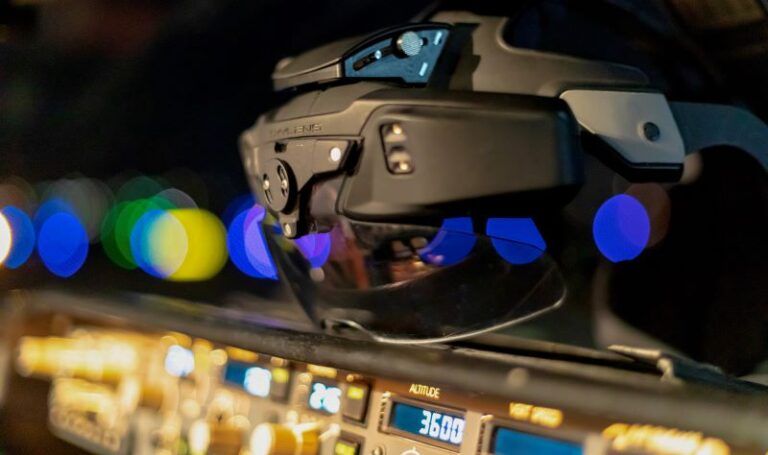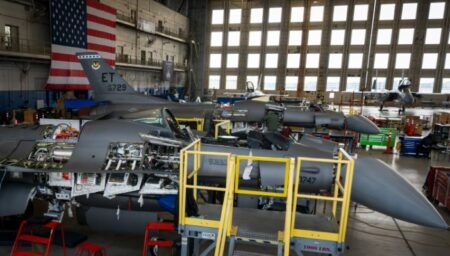AerSale, a leading provider of systems, products, and MRO services, has received a supplemental type certificate from the FAA for its AerAware head-wearable EFVS/SVS systems based on Universal Avionics ClearVision technology.
AerAware will incorporate Universal’s SkyLens head-wearable displays with a single EVS-5000 multispectral camera. The head-wearable display (HWD) display near the pilot’s eyes can combine both enhanced vision and synthetic vision systems in a fused image along with real-time primary flight display symbology.
The two companies said the user can control this combined vision system to improve day and night views during gate-to-gate low-visibility operations in adverse weather.
AerAware provides a high-fidelity view of the outside world when actual visibility is close to zero. 737NG pilots will be able to conduct low-visibility approaches on instrument approach procedures with DA or DH such as ILS or WAAS LPV while viewing the runway environment and obstacles through the weather. The system can detect LED runway and taxiway lights sooner than the naked eye and aid pilots in seeing runway lights better than they can unaided during a low-visibility approach.
When the FAA issued the STC in December 2023, AerSale and Universal said this marked the first time the FAA certified HWD in the U.S. market, providing the captain and first officer on a transport aircraft with EFVS systems using two HWDs. The AerAware system also stands out as the first commercial EFVS system to be credited by the FAA with a 50% reduction in prescribed visibility requirements over unaided pilot vision.
Certification and customers
AerSale worked on the certification program under license to Boeing and plans to market AerAware to operators of the 737NG in the airline industry.
Universal received a US$33 million contract in July 2022 to supply SkyLens displays and cameras to AerSale for the project. ClearVision technology already has more than 3,000 EVS cameras in service. This includes EVS manufactured by Universal’s parent company, Elbit Systems, since the early 2000s, including EVS-I, EVS-II, EVS-SP and EVS-5000, the latter for the 737NG.
“With this contract with Universal, we’re ensuring deliverability of the AerAware system to the growing number of airlines who have expressed interest in this system,” said Nicolas Finazzo, chairman and CEO of AerSale. “We are bringing this innovative solution to commercial operators for improved safety and operational effectiveness, and we’re seeing a lot of excitement as we conduct demonstration flights.”
The ClearVision EFVS solution brings substantial capabilities to the 737NG and has demonstrated its advantages to operations, including the ability to overcome degraded visibility solutions during any time of day,” said Dror Yahav, CEO of Universal Avionics. “I believe the ability to allow aircraft to operate in conditions well below published minimums is a game-changer.”
The extensive certification flight testing campaign comprised 48 flights in 13 different states during which 98 hours of flight testing were logged along with 102 approaches to 29 different airports.
The flight test procedure included several phases, including approval of the ClearVision SkyLens HWD as equivalent to a fixed head-up display. The HWD is more flexible than a HUD for the pilot because it does not require him or her to sit in a specific seat position while maintaining crew awareness of critical flight information as they look out the window in all directions.
Flight tests also evaluated the EVS, SVS and combined vision systems, EFVS approach and landing and visual advantage testing. Combining EVS and SVS into a fused image with primary flight display symbology increases pilot situational awareness during low visibility.
To attain a 50% visual advantage, flight testing required many approaches in varying conditions at different airports. The system provides credit on landing by effectively reducing RVR requirements, facilitates operations in unfamiliar or difficult airports, and provides credit on approach allowing aircraft to descend below ILS Category 1 minimums, typically of 200ft, all the way to touchdown and rollout with RVR equal to about 1,000 feet.
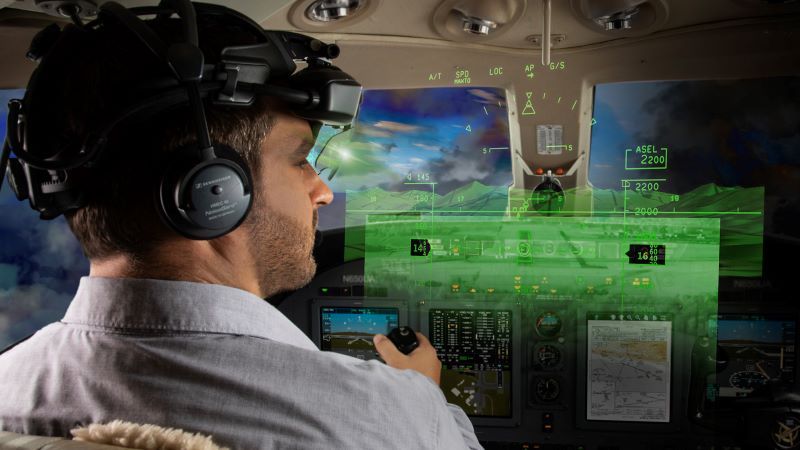
Visibility sensors and cameras
The system does not provide credit on take-off, but an aircraft can push back from the gate if the reported visibility with EFVS is sufficient. With a visual advantage of 50%, this means the reported visibility can be half of what is prescribed on the approach charts.
The EVS-5000 has six sensors that cover the spectrum from visible light to longwave infrared, and the data is combined into one perfectly fused picture, according to Universal. This includes four cameras and some RGB surface light sensors. A single EVS-5000 is mounted on the nose of the aircraft.
In addition, Universal makes the more compact EVS-4000 multispectral EVS camera with two sensors covering visible near IR and long-wave IR. This can be installed on smaller fixed-wing aircraft and rotorcraft such as the King Air B200 and the Leonardo AW-169.
Pilots can display a split presentation with SVS on top of EFVS or vice versa so the pilot can select the display configuration he or she prefers while adjusting image brightness of the two images independently.
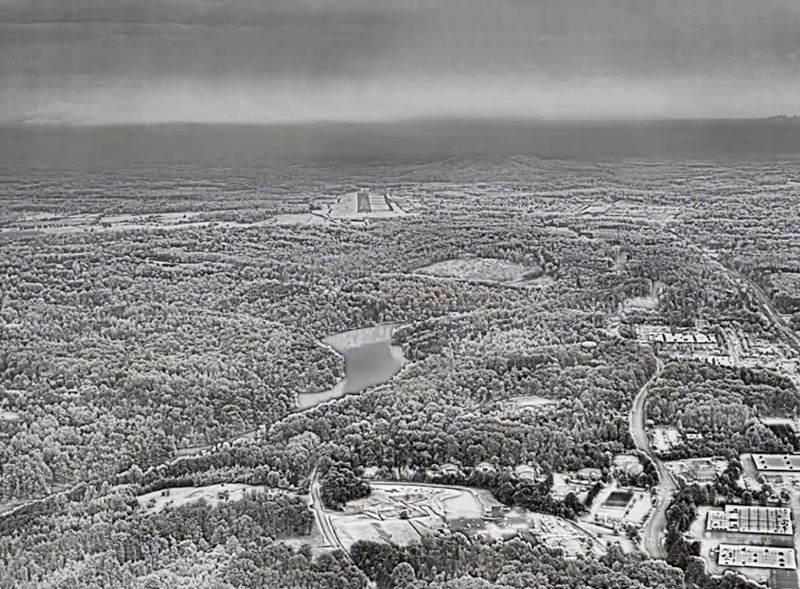
SkyLens was previously certified by EASA and used by launch customer Aurigny on its fleet of ATR twin turboprop aircraft. The airline flies in and out of Guernsey Island, the second-largest Channel Island.
The SkyLens HWD is now an option on the ATR 42/72-600’s new Standard 3 avionics suite. This is a twin turboprop with seating for 44 to 78 passengers. A study showed the use of Universal EVS could save half of the 48 landings prevented by low visibility in Guernsey during one year. The system is helping the airline avoid delays and cancellations.
The airline paid €1 million US$1.07 million) in 2017 for the cost of accommodating stranded passengers, including mostly hotel stays due to delays, diversions and cancellations. Avoiding similar schedule disruptions is one reason AerSale expects 737NG operators to acquire AerAware. Avoiding diversions can also cut down on fuel costs, airframe hours and carbon dioxide emissions.
Retrofit installation
Universal’s SkyLens HWD’s compact design and straightforward installation process makes it applicable across a wide range of aircraft platforms with no restrictions on aircraft size, according to the company. Business jets and airlines already used fixed head-up displays, but Universal said the HWD provides a wider field of regard.
A pilot can look 180 degrees left or right with the system while retaining situational awareness of terrain and critical aircraft information. And the system has a smaller footprint in the cockpit than affixed HUD with both weight and size savings.
SkyLens uses a visor to provide display of imagery and data with transparency that is easy to see through. Universal said the HWD is lightweight and comfortable and more ergonomic than a fixed HUD. The visor provides a view of the outside world with aircraft, mission, terrain, flight, obstacle and navigation data incorporated.
Universal received a TSO for its Aperture product line. Aperture uses EVS as an input source and provides output through multiple sources such as SkyLens. Aperture combines multiple video and image sources quickly into a seamless and complete picture. It enables images with different fields of view to be combined so they can be viewed by the flight crew.
After several years of development, Aperture is now in its second phase of work so it can perform low-latency video aggregation and manipulation with independently generated symbology and synthetic imagery. Aperture will perform content analysis and present information in the form of augmented reality to increase pilot situational awareness and decision-making during a critical phase of flight.
Visibility enhancements for fighting wildfires
Aperture will also be able to enhance the visual image and intelligently detect obstacles and prevent incursions. So other aircraft, airports, birds as they are flying can be seen without delay for complete situational awareness and to enable proactive decisions. This technology will be able to automatically identify the position of the runway and outline it for the crew and also designate the lateral and vertical deviation from the touchdown zone and runway centerline. Universal said these types of capabilities will be available for AerAware at some point in the future.
The SkyLens HWD has completed type inspection approval flights on a King Air B200 with the EVS-4000, but Universal does not currently intend it for use on general aviation aircraft. While the top-of-the-line EVS-5000 multispectral camera has six sensors from visible light to longwave infrared, the EVS-4000 has two sensors from visible near infrared to long-wave infrared for aircraft no smaller than a King Air or a PC-12NG.
Universal also will be offering the SkyLens HWD with EVS and SVS for King Air B200s used as a lead plane to fight wildfires and for air attack missions. The safety benefit of SVS and EVS when spotting fires for tanker crews is obvious, as this task may one day be performed around the clock in all weather.
“The ClearVision system provides unparalleled situational awareness to fight wildfires during the day and into the night where visibility is near zero,” said Woody Cottner, vice president of business development for Global Aviation Technologies. Global is a full-service MRO company based in Wichita, Kansas.
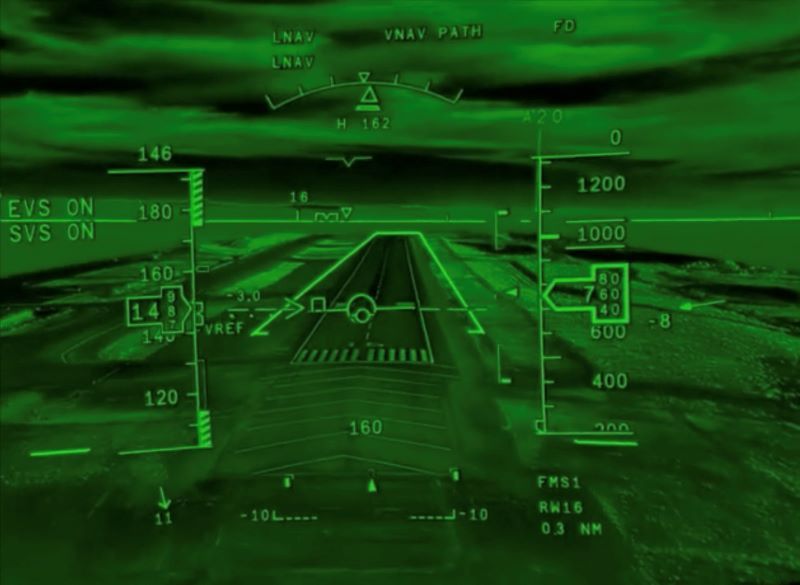
Universal also offers the SkyVis helmet-mounted display with ClearVision EFVS with head-up symbology for out-the-window helicopter operations. This system is being developed for forward-fit and retrofit by helicopter manufacturers and corporate transport and mission operators around the world. It has day, night and NVG capability.
Universal and Heli-One AS of Norway completed flight tests of SkyVis helmet-mounted monocle-type displays in June 2022. Universal is seeking an EASA STC on the H215 (aS332L1e) helicopter, the first civil rotorcraft certification of an HMD. Similar work is underway with Leonardo on the AW169. The third partner in the effort is the Bundespolizei-German Federal Police. The system allows the pilot to keep primary information such as instrument, engine and navigation data in view when turning his head. This is particularly helpful when a pilot is executing demanding maneuvers such as a hover. The system is expected to improve mission accomplished rates while enhancing safety. Universal recently expanded its European office due to the growing market for its products.
Universal offers a variety of state-of-the-art, rugged avionics for the high-vibration environment of helicopters, including for the unique requirements of tactical missions. It also has night vision goggle compatible options available on many of its products. The latest avionics are offered for the AgustaWestland A109, AW139; the Airbus AS332 Super Puma, EC-135/155, BK117, AS 365 Dauphine; Bell 212, 214ST, 412, 430; MIL MI-17, MI-172; and the Sikorsky S-70 Black Hawk, S-76, S-92 and UH-60 Black Hawk.
Universal offers a full range of state-of-the-art avionics to upgrade the cockpits of established aircraft, including the King Air 90/100/200/300/350; Bombardier Challenger CL-600/601; Cessna Citation 1/SP501, II 550, II/SP551, III 650, VII; Dassault Falcon 50, 900/B, 2000/EX; Gulfstream GII-G5, Learjet 31A, 35/36, 45, 55, 60; and the Hawker 800/1000. Repair shops can contact Universal about upgrading other model business jets.
The late Hubert L. Naimer founded Universal Avionics in the early 1980s and introduced one of the first flight management systems in the industry. In 2018, the Naimer family sold the company to Elbit Systems in Israel, and it became a US subsidiary of that large aerospace defense company. Elbit has developed several generations of helmet-mounted systems in the past two decades for civil and military use, including the Israeli Air Force. Elbit also co-owns a joint venture subsidiary with Collins Aerospace developing these types of systems.
To learn more about Universal Avionics, visit universalavionics.com


